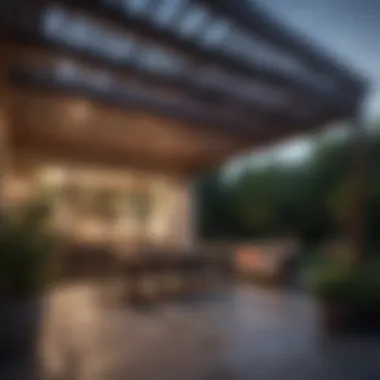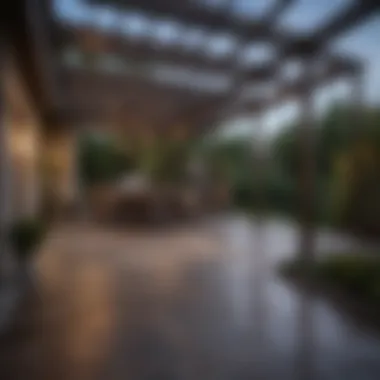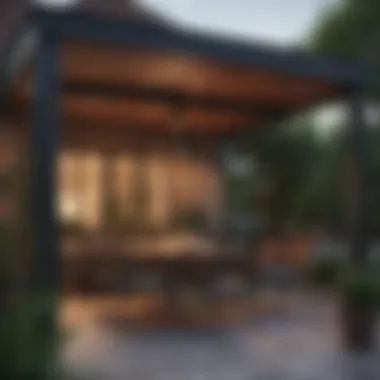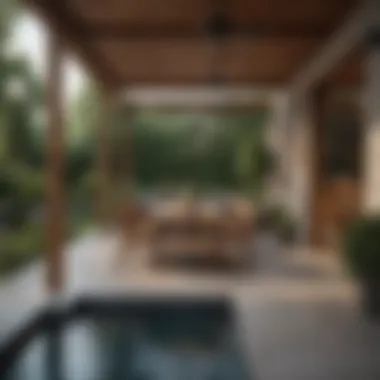Comprehensive Covers for Back Patios: A Practical Guide


Intro
Back patios serve as an essential extension of the home. They create a bridge between indoor and outdoor living, enabling families to enjoy nature while remaining comfortable. However, with varying weather conditions and seasonal changes, protective covers become crucial for maintaining these spaces. A well-selected cover not only provides shelter but also adds to the aesthetic appeal of the area.
In this guide, we will explore the multiple layers involved in choosing the right cover for a back patio. From design inspiration to practical installation tips, the aim is to equip homeowners, interior design enthusiasts, and gardening aficionados with the knowledge to make informed decisions. Each section will delve into aspects such as material options, current trends, and maintenance tips relevant to creating a conducive outdoor environment.
Understanding the Purpose of Back Patio Covers
Back patio covers serve a significant role in enhancing the utility and enjoyment of outdoor spaces. These structures provide shelter from various weather conditions, allowing homeowners to utilize their patios throughout the year. Understanding their purpose goes beyond simple coverage; it encompasses both functional and aesthetic dimensions that contribute to a better outdoor experience.
Functional Benefits
The primary functional benefits of back patio covers include protection from the elements. Rain, sun, and harsh winds can deter outdoor activities, but a well-designed cover offers a respite. It creates a usable outdoor space, whether for entertaining guests or relaxing alone. Moreover, patio covers can help regulate temperature, offering a cooler area to escape the summer heat. By reducing the amount of direct sunlight, they can also help protect furniture and flooring from premature fading and deterioration.
Additionally, back patio covers can be an energy-efficient choice. By providing shade and cooling effects, they reduce the reliance on air conditioning during hot months. This translates into energy savings for the homeowner. Furthermore, some covers are designed to collect rainwater, which can be repurposed for garden irrigation, promoting sustainable living practices.
Aesthetic Enhancements
Aesthetic considerations are equally important when it comes to patio covers. They can significantly alter the visual appeal of an outdoor area. By selecting the right design, materials, and colors, homeowners can enhance the overall look of their homes. Properly chosen, a patio cover can complement the architecture of the house, adding to its market value and curb appeal.
Moreover, patio covers can serve as a focal point in landscaping. For instance, a beautifully crafted pergola can transform a simple outdoor space into an inviting retreat. The choice of materials—be it wood, metal, or fabric—allows homeowners to express their style and enhance the garden's beauty. These enhancements create a more comfortable and inviting area for socializing or solitary reflection.
Choosing the right back patio cover allows homeowners to not only protect their outdoor spaces but also enhance every aspect of their lifestyle.
Ultimately, understanding the purpose and potential of back patio covers is essential for homeowners. They offer more than mere shelter; they contribute to functionality and aesthetics, enriching outdoor living experiences.
Types of Back Patio Covers
The choice of a back patio cover is an essential part of optimizing outdoor living spaces. Selecting the right type impacts the utility, aesthetics, and comfort of these areas. Therefore, it is vital to explore various categories of patio covers, understanding their specific advantages and their suitability to different lifestyles and environments.
Permanent Structures
Permanent structures are typically durable and provide long-term benefits for homeowners. These solutions can transform a backyard into a more usable space, suitable for various activities, regardless of weather conditions.
Pergolas
Pergolas are an attractive option for enhancing outdoor areas with structure and support. They consist of vertical posts along with cross beams that create an open framework. The open design allows natural light to filter through, which is a unique charm.
The light-filtering aspect gives pergolas an inviting feel, making them suitable for gardens and pathways. Homeowners enjoy customizing them with climbing plants for additional shade or ambiance. However, they may not provide complete protection against rain or harsh sun, making additional shades necessary.
Gazebos
Gazebos are freestanding structures that offer a more enclosed space. They often have a roof and can include open walls or railings. This design contributes to overall comfort and protection against elements. Homeowners appreciate gazebos for their versatility when hosting gatherings. They create a gathering point and can be furnished with seating and decor.
A notable characteristic of gazebos is their ability to provide shelter while allowing for ventilation, offering coolness on warm days. However, the installation process could demand more time and financial investment compared to simpler structures.
Solid Roof Patio Covers
Solid roof patio covers offer the most comprehensive protection compared to other options. They are constructed from materials like metal or shingles that completely shield the area beneath from weather conditions. This type ensures that outdoor furniture and spaces remain dry and safe from harsh sunlight.
A significant advantage of solid roof covers is their ability to create an extra room-like atmosphere. Homeowners can also use these spaces year-round. However, they often require a more significant initial investment and proper drainage systems to avoid water pooling on the roof.
Temporary Solutions
Temporary patio covers provide flexible and cost-effective alternatives for those who may not need a permanent installation. These options allow for easy assembly and disassembly, making them ideal for seasonal use or casual gatherings.


Canopies
Canopies are lightweight and portable coverings that come in various sizes. Their versatility makes them suitable for any outdoor gathering, offering quick setup without permanent fixtures. Many homeowners find canopies beneficial for tailgates, picnics, or outdoor parties.
The lightweight nature means they can be easily moved as needed. However, they may be less stable in strong winds and require careful attention during storms or bad weather.
Shade Sails
Shade sails are made of durable fabric stretched between anchor points, providing a unique and modern aesthetic. They effectively block sunlight while allowing air to circulate, creating a comfortable outdoor space. Homeowners often choose shade sails to add a contemporary flair to their patios while ensuring protection from harmful UV rays.
The installation is relatively simple, but they require the right anchor points. If not well-anchored, they may flap in the wind, calling for regular checks and maintenance.
Umbrellas
Umbrellas are classic solutions for shade that offer superb convenience. They are typically quick to install and easy to relocate. Homeowners use them on patio tables or standalone positions to provide necessary shade during sunny days. Many designs are available, catering to various sizes and styles.
A disadvantage is that they provide limited coverage and may not withstand strong winds unless secured properly. Frequent manual handling is another consideration for maintenance and protection.
Retractable Options
Retractable options enable customization of shade and coverage based on immediate needs. They can be drawn back when unnecessary and extended when the weather requires.
Awning Systems
Awning systems are versatile and efficient for controlling sunlight and rain. They are attached to the exterior wall of the home and can be manually or motorized operated. Many homeowners prefer them for their ability to enlarge the usable outdoor space dynamically.
The convenience of awnings comes with complex installation processes if seeking automatic types. Their longevity and effectiveness make them popular in moderate climates.
Motorized Shades
Motorized shades provide high-tech solutions for convenience and control over light. These shades can adjust with a press of a button, making them appealing for modern homeowners. They can fit various window sizes and patio openings, enhancing comfort and usability.
However, they may involve higher initial costs and depend on electricity or batteries for functionality. Proper maintenance of the motorized elements is also necessary to ensure long-lasting performance.
Choosing the Right Material
Selecting the right material for back patio covers is key in achieving a balance between functionality and aesthetics. The material will influence not only the durability and maintenance needs but also the overall visual appeal of the outdoor space. Different materials offer various benefits, making the choice a critical aspect of the project. Understanding the characteristics of each material can guide homeowners in making an informed decision that aligns with their specific requirements and style preferences.
Wood
Wood is a classic choice for patio covers, often preferred for its natural appearance. It provides warmth and charm that can enhance the overall ambiance of a back patio. Options like cedar, redwood, and pressure-treated pine are particularly popular due to their resistance to decay and insect damage. However, wood requires regular maintenance, including staining and sealing, to preserve its appearance and longevity. A well-maintained wooden cover can last decades but may need treatment every few years to protect against weather elements. Additionally, wood can be customized easily through paint or stain, allowing for a personal touch in either traditional or modern settings.
Metal
Metal covers, often made from aluminum or steel, represent a sturdy and low-maintenance option. They are resistant to rot, warping, and pests, making them ideal for harsher environments. Aluminum is particularly lightweight and can be finished in various colors to adapt to different design needs, while steel provides durability and strength but may require some rust-proof treatment. Metal structures can be designed in multiple styles, from sleek modern designs to more traditional looks. However, metal can retain heat, so choosing a reflective finish or combining it with additional shading solutions is advisable, especially in hot climates.
Fabric
Fabric covers offer a much lighter and more flexible option for patios. They come in various colors and patterns, which can significantly contribute to the aesthetic appeal of the space. Materials like canvas or polyester are common choices because of their versatility and ease of installation. Fabric can provide a cozy ambiance while offering protection from light rain and UV rays. However, they are generally less durable than other materials and may require seasonal replacement or additional care, such as washing or waterproofing. When choosing fabric covers, considering their resilience against fading and tearing is important for maintaining an appealing outdoor environment.
Polycarbonate and Acrylic
Polycarbonate and acrylic are synthetic materials that provide unique advantages for patio covers. Polycarbonate is known for its exceptional durability and impact resistance, allowing it to withstand extreme weather conditions while still letting light through. Acrylic, on the other hand, is lighter and has excellent clarity, making it a popular choice for allowing natural light onto the patio while providing some level of insulation. Both materials require minimal maintenance and can be an attractive option, particularly in modern designs. However, care should be taken to prevent scratching and to ensure they are installed correctly to manage water drainage effectively.
"Choosing the right material should reflect not just functionality, but also personal style and the overall vision for your outdoor space."
Design Considerations


When creating a back patio, design considerations play a significant role. They influence how the space functions and how it looks. A well-designed patio cover can elevate an outdoor area, providing both aesthetic and practical benefits. Here, we will explore some critical aspects of design to ensure a harmonious integration of the patio with the existing home structure and landscape.
Aligning with Home Aesthetics
The first step in designing a patio cover is to align it with the existing home aesthetics. Achieving a cohesive look can enhance the overall appeal of the property. This involves considering architectural styles, colors, and materials used in the house. For example, if the home features modern lines and a sleek exterior, a simple, minimalist patio cover may be appropriate. On the other hand, a rustic home may benefit from wooden structures or decorative elements that reflect its charm.
In addition to style, color can also unify the patio with the home. Choose shades that complement or match the exterior colors. This not only enhances visual appeal but also creates a tranquil outdoor environment. For instance, a white or light-colored cover can make a cozy space feel larger and more open. Seeking advice from local designers or visiting places like reddit.com can provide inspiration and guidance.
Maximizing Space
Maximizing space is vital when designing a back patio cover. The goal is to create a functional area without overwhelming the existing space. First, consider the size of the patio. The cover should fit proportionally; a large cover may dwarf a small patio, while a small cover might get lost in a vast area. This balance can optimize usability while maintaining an open feel.
Also, utilize vertical space. High ceilings or sloped roofs can create a sense of height, making the area airier. Integrating built-in furniture or storage solutions can also enhance functionality. For example, incorporating benches or shelves can convert unused areas into spaces for relaxation or storage. Moreover, when planning furniture placement and movement paths, ensure they allow for free flow within the area.
Integrating with Landscape
The relationship between the patio cover and surrounding landscape is crucial. A successful integration enhances the outdoor experience by connecting the patio to the garden or yard. Consider the surrounding elements such as plants, trees, or water features. Designing a cover that complements these elements helps create a harmonious environment.
For instance, if there are tall trees nearby, it's essential to position the cover to allow light filtration while providing shade. Landscaping can also guide the design of the cover. Using materials from nearby plants, such as stone or wood, can create a seamless transition between the built spaces and nature. This method not only supports a unified design but also leverages the natural beauty of the landscape.
Key takeaway: Thoughtful design considerations for back patio covers ensure a balance between functionality and aesthetics. Aligning with home styles, maximizing space efficiently, and integrating with the landscape are paramount for creating a beautiful outdoor oasis.
Installation Considerations
The installation of back patio covers is a crucial process that significantly influences the effectiveness and longevity of the structure. Proper planning and consideration can greatly enhance the enjoyment and functionality of the outdoor space. Installation can encompass various factors, such as cost, structural integrity, and overall aesthetics. These considerations will ultimately determine the satisfaction of homeowners with their new patio cover, serving as a crucial part of their outdoor living experience.
DIY Versus Professional Installation
Deciding whether to undertake a DIY project or hire professionals is a central concern for many homeowners. DIY installation can offer cost savings, but it requires a good understanding of construction methods and tools. Homeowners should assess their skill level before proceeding.
Professional installation brings expertise and efficiency. Pros can navigate complex aspects of the installation, from ensuring structural stability to adhering to local building codes. Additionally, they can complete the project more swiftly, allowing homeowners to enjoy their new patio cover sooner.
It’s essential for homeowners to weigh the pros and cons of each route. Factors such as time availability, budget, and desired quality should influence the decision.
Permits and Regulations
Understanding and navigating the necessary permits and regulations is vital for a successful installation. Most localities have specific codes governing outdoor structures. Failure to secure appropriate permits can result in fines and even the requirement to dismantle the cover.
Homeowners should approach their local building department to verify what permits are required for their project. They should also inquire about any design restrictions. Some neighborhoods have homeowner associations that impose additional regulations. Ensuring compliance not only avoids legal issues but often enhances the value of a property.
Site Preparation
Proper site preparation is foundational for a successful patio cover installation. This involves assessing the chosen location for the patio cover for level ground and appropriate drainage. Uneven terrain can lead to structural issues and water accumulation, which jeopardizes the integrity of the cover.
Homeowners should consider the following steps for effective site preparation:
- Clearing the Area: Remove all debris, plants, or obstacles from the site.
- Leveling the Ground: Use tools such as a spirit level or laser level to ensure an even surface.
- Marking the Layout: Clearly mark where the patio cover will stand, taking into account sunlight, shade, and landscaping.
Taking these proactive steps helps ensure that the installation process is smooth and the end result meets expectations.
Maintenance Tips for Longevity
Maintaining back patio covers is essential for ensuring their longevity and functionality. Regular upkeep can prevent minor issues from escalating into major repairs. It is not only about aesthetics but also about preserving the investment a homeowner makes in their outdoor space. This section addresses actionable steps that every homeowner should consider.
Routine Cleaning and Upkeep


Routine cleaning should not be taken lightly. Dirt, debris, and moisture can cause damage over time. The type of material used in the cover influences the cleaning method. For example:
- Metal Covers: Use a soft cloth and a mild detergent. Rinse thoroughly to avoid residue.
- Wood Covers: A pressure washer can be effective, but don't get too close to avoid damage. Follow up by applying a water-repellent sealant every few years to prevent rot and warping.
- Fabric Covers: Look for a specific fabric cleaner or use a mixture of mild soap and water. Ensure they dry completely to prevent mildew.
Regular inspections are also critical. Look for rust on metal structures, rot on wooden components, and tears in fabric covers. Addressing any issues promptly can save time and money later.
Seasonal Preparations
Preparing your patio covers for seasonal changes is vital. Different seasons bring different challenges. Consider the following:
- Spring: Inspect for winter damage. Clean off any debris that may have accumulated.
- Summer: Ensure that your covers provide adequate shade. Monitor for any wear, especially if the cover is fabric. Sun exposure can weaken materials.
- Fall: Clear leaves and other debris to prevent clogging gutters if applicable. This helps to prevent moisture buildup which can lead to mold.
- Winter: If possible, remove fabric covers or lower awnings to reduce snow accumulation. Use a broom to gently clear snow from hard structures.
Addressing seasonal maintenance will extend the life of your covers significantly.
Addressing Damage
Every patio cover faces potential damage from weather and use. When damage occurs, timely action is needed. For example:
- Cracks in Metal: These can be repaired with metal epoxy or welding, depending on severity.
- Rot in Wood: Replace rotting sections of wood as soon as detected. If the entire cover is affected, consider a complete replacement.
- Tears in Fabric: For smaller tears, use a fabric patch kit; for larger damage, replacing the fabric may be more effective.
"Prevention is always better than cure. Taking care of minor repairs can save homeowners from costly replacements in the future."
Being vigilant and proactive about maintenance increases the durability of back patio covers, ensuring they remain both functional and visually appealing for years.
Cost Considerations
When deciding to install a cover for a back patio, understanding the cost implications is critical. Not only do these covers provide functional benefits, they can also significantly affect property value. Knowing how much to invest and what potential savings can be generated over time is vital for any homeowner looking to enhance their outdoor space.
Initial Investment
The initial investment for a back patio cover varies based on multiple factors. The type of cover chosen, the materials used, and the complexity of installation all play significant roles in determining the total cost.
- Type of Cover: Permanent structures like pergolas or gazebos typically require a higher upfront investment compared to temporary solutions like awnings. For example, a solid roof cover may range between $3,000 to $15,000 depending on size and materials.
- Materials: Wood, metal, and fabric each have their own cost structures. Wooden patio covers may need painting or weatherproofing, which adds to the cost. On the other hand, metal covers often have a longer lifespan but can be pricier initially.
- Labor Costs: If opting for professional installation, labor costs can also add significantly to the overall expenditure. DIY solutions can reduce costs, but they come with their own risks and considerations.
It’s wise to have a budget in place before starting this project. Consider getting quotes from multiple contractors to ensure you understand the price range specific to your area.
Long-Term Savings
Looking beyond the immediate costs, potential long-term savings from a well-chosen back patio cover should not be overlooked. A well-installed cover can improve energy efficiency and add to the overall durability of outdoor spaces.
- Energy Efficiency: A solid roof patio cover can reduce heat gain during summer months. This means less reliance on cooling systems, translating to lower energy bills over time. The insulation properties of certain materials can also provide benefits during colder months.
- Maintenance Savings: Selecting durable materials reduces the frequency of repairs or replacements. For instance, metal roofs typically last longer than fabric options, which may require more frequent replacements. Less maintenance translates to additional savings.
- Property Value Increase: Aesthetic and functional improvements from a quality patio cover can enhance property value. This investment might yield substantial returns if the home is resold, making the initial outlay worthwhile.
"Investing in a back patio cover is not just about immediate enjoyment but also long-term benefits for your property."
Future Trends in Patio Covers
As homeowners increasingly recognize the value of outdoor spaces, the importance of patio covers is more pronounced than ever. Trends in this area are evolving, shaped by several factors, including innovations in materials and changing aesthetic preferences. Understanding these trends helps homeowners make informed choices for their patio projects.
Sustainability in Materials
With growing concern for the environment, sustainability has become a central theme in the selection of patio cover materials. Manufacturers are now producing options that prioritize eco-friendly practices. For instance, bamboo is gaining popularity due to its rapid renewability and strength. Similarly, recycled metal is used not just for its durability but also for its reduced environmental impact.
Another trend is the use of synthetic materials that imitate traditional choices like wood but offer superior longevity and lower maintenance. Brands now focus on creating products that reduce waste and carbon footprints, appealing to environmentally conscious consumers. By selecting sustainable materials, homeowners contribute positively to the planet while enhancing their outdoor space.
Innovative Designs
The design landscape for patio covers is transforming significantly, driven by both functionality and aesthetic appeal. Homeowners are moving towards minimalist styles that provide sleek, clean lines with open layouts. For example, bioclimatic pergolas, which adjust their slats to control sunlight and airflow, are becoming increasingly popular. They offer versatility in functionality and elegance in design.
Another innovative approach is the integration of smart technology. Automated patio covers allow users to manage the amount of sunlight or shade via mobile applications. This feature not only adds convenience but also enhances energy efficiency around homes.
Additionally, mixed materials are seeing a rise in use. Combining wood, metal, and fabric can create a unique and personalized outdoor experience. This blending of textures adds depth to design and allows for creative customization.
"Innovative designs not only enhance the beauty of patios but also introduce functionality that meets modern lifestyle needs."



